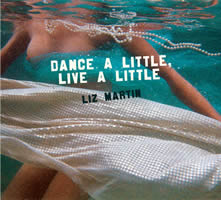Liz Martin
|
Miri Jassy [September 2011.]
Liz MARTIN: Dance a Little, Live a Little (2011). Martin (vocals), Dave Symes (bass, arrangements), Hamish Stuart (drums), Stu Hunter (keyboards), Veren Grigorov (violin, viola), Dirk Kruithof (gtr), Mr. Percival (guest vocal on “Sound and Vision”). Vitamin Records VT0055 (http://www.vitamin.net.au/). The louche drawl of a superb horn section plays tag with Liz Martin’s delicate vocals on the new album Dance a Little, Live a Little. Jazz singer, indie chanteuse — Liz Martin isn’t to be categorised that easily. Undeniably nourished by jazz — but far from anything esoteric and improvised, Martin’s sound is a playful embrace of the savvier side of pop with a massage from the cool hands of dashing crooners. Combining her sultry growl and a tight rhythm section, she is what happens when a Brubeck-influenced, Blue Note aficionado inhabits a grrrl balladeer who survived the grungiest excesses of the 1990s. Consequently, Martin’s music is profoundly sexy. In the case of Dance a Little, Live a Little, you must judge the album by its cover. In perhaps an offhand improvement on Janet Jackson’s infamous oops moment, Liz Martin’s submerged nude figure is utterly stylish. Clad in a dissolving white dress against a turquoise backdrop, this image of Aphrodite-like rebirth promises what the music delivers: fragile beauty emerging with a refreshed style. Think Leonard Cohen but low on bombast, and Tom Waits but low on gravel. With this new album, Liz Martin’s songs are gentle but assured, and any lyrical melancholy is never shot through with self-loathing. It’s a relief that her tortured and torch-lit indie days are over; not that there wasn’t a hint of her curious mix of strength and delicacy in her earlier and noticeably darker material. When I heard Liz Martin in a mid-noughties performance at a local café turned low-lit troubadour club, teaming up with fellow indie songbird Inga Liljestrom, she was captivating. I harbour memories of breathtaking sadness and troubling darkness that are happily absent from Dance a Little, Live a Little. The bouncy staccato of album opener “So Long” initiates the listener into the tone of personal liberation that infuses the album. Martin’s vocals are suggestive of a deceptively relaxed timbre — she lands somewhere under the note, then beside it, caressing the note and sliding from it into the next clipped lyric. The jaunty piano of “So Long” returns in the following track, “Be What May.” The song is compact, witty, rhythmically delicious and a stylish dialogue of horns and voice. The joy of these arrangements erupts in the title track. “Dance a Little, Live a Little” skips, wriggles and grabs you by the hand. Here the sensual voice again takes hold: You’ll want to hear just a little bit more of this very “little” song — a modest song for one that is instantaneously exciting. “Meanwhile” is a bemusing “entr’acte” evoking a late ’60s James Bond theme. For those Liz Martin fans attracted to the singer’s moody good looks as well as her music, the steamy sound of high heels (Liz’s own or perhaps an elusive paramour’s) is the star of this bite-sized noir soundtrack. The thrills continue with a strange but cunningly wrought jazzy reworking of Bowie’s “Sound and Vision.” Liz Martin’s cover is a perfect translation. “Olives and Wine” builds on the sensuality theme inspired by the spontaneous swim of the album packaging. This song signals the moment when the lights are dimmed and the band leader calls up a slow dance. Romantic but not sappy, it’s a wedding dance for the thinking woman. “Wish” and “Long Bad Day” echo the earlier brass cahoots on “Be What May.” “Wish” is a perfect song of desire. It’s confessional but smart, with rhythms stunningly reminiscent of Tom Waits’ Alice album. Strings, double bass and snare paint a canvas of cool moodiness that undercuts the yearning of the song. There’s no room for gloom, as “Long Bad Day” attests. Suave piano and horns make an almost comedic meal of the minor keys, syncopating and finger-snapping their way through another perfect little song. “Night Time” follows the gentle and piano-showcase of “Oh” as a memorable and definitive track. Infused with the charcoal hues from a brooding electric guitar, Liz Martin’s breathy lyrics are holding a candle for one that got away. Despite the yearning, the beautiful, dark melody suggests controlled passion. Resolution rewards listeners in the final two tracks. “Darling” is a song that’s wrapped in the warmth of another Dave Symes string arrangement, with Stu Hunter’s understated piano a match for Liz Martin’s vocal subtlety. The farewell notes of this final-sounding song are conclusively charming, but for a sneaky closing track, “Early Morning Skies.” With a dainty, homespun sound which chirps sweetly along with Dan Waples’ clarinet, it’s another optimistic moment in an upbeat album. Without surrendering her serious side, Liz Martin has delivered a sparkling album. Familiar sounds of traditional jazz quartets are enchanted with sweet strings and growling guitar. While obviously a collaborative musical effort, the personal drive to bring it all together and take creative risks belongs to Liz Martin. A local hero of Sydney’s inner-city bohemian set, Martin’s music is gradually gaining wider audiences in Australia, with airplay and coverage across national media. With her delectable melodies, and a voice that ditches full-throttle ego for laid-back swagger, Liz Martin will undoubtedly turn heads and win fans. After hearing Dance a Little, Live a Little I want to dance and live a whole lot more, sensing that more great music is surely not too far off in her brilliant career.
[More Miri Jassy]
[Previous Article:
String Theory 5: Sometimes with Piano]
[Next Article:
Why Mahler Should Rest]
|
